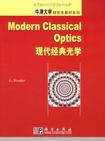现代经典光学布鲁克作者简介、书籍目录、内容摘要、编辑推荐

从现代的视角描述了经典光学,也可称为“半经典光学”。书中内容大都与经典光学相关,包含了相关的现象、仪器和技术,以及一些常见的主题:衍射、干涉、薄膜和全息光学,也涉及了高斯光束.激光腔、cD阅读器和共焦显微镜。涉及少量的量子光学。《现代经典光学》内容丰富、新颖,讲解透彻,各章最后均附有相关习题,书末附有部分习题的解答,可供高年级本科生及低年级研究生参阅,也可作为相关领域研究人员的参考书。 《现代经典光学》作者为牛津大学物理系的Geoffrey Brooker。
书籍目录
1 Electromagnetism and basic optics1.1 Introduction1.2 The Maxwell eqiations1.3 Linear isotropic media1.4 Plane electromagnetic waves1.5 Energy flow1.6 Scalar wave amplitudes1.7 Dispersive media1.8 Electrical transmission lines1.9 Elementary(ray)optics1.9.1 The thin lens1.9.2 Sign conventions1.9.3 Refraction at a spherical surface1.9.4 The thick lens1.10 Rays and wavesProblems2 Fourier series and Fourier transforms2.1 Introduction2.2 Fourier series:spectrum of a periodic waveform2.3 Fourier series:a mathematical reshape2.4 The Fourier transform:spectrum of a non-periodic waveform2.5 The analytic signal2.6 The Dirac nction2.7 Frequency and angular frequency2.8 The power spectrum2.9 Examples of Fourier transforms2.9.1 A single rectangular pulse2.9.2 The double pulse2.9.3 A2.9.4 A regular array of2.9.5 A random array of2.9.6 An infinite sinewave2.10 Convolution and the convolution theorem2.11 Examples of convoltion2.12 Sign choices with Fourier transformsproblems3 Diffraction3.1 Introduction3.2 Monochromatic spherical wave3.3 The Kirchhoff diffraction integral3.4 The Kirchhoff boundary conditions3.5 Simplifying the Kirchhoff inregral3.6 Complementary screens:the Babinet principle3.7 The Fraunhofer condition I:provisional3.8 Fraunhofer diffraction inone dimension3.9 Fraunhofer diffraction intwo dimensions3.10 Two ways of looking at diffraction3.11 Examples of Fraunhofer diffraction3.12 Fraunhofer diffraction and Fourier transforms3.13 The Fraunhofer condition Ⅱ:Rayleigh distance and Fresnel number3.14 The Fraunhofer condition Ⅲ:object and image3.15 The Fresnel case of diffraction3.16 Fraunhofer diffraction and optical resolution3.17 Surfaces whose fields are related by a Fourier transform3.18 Kirchhoff boundary conditions:a harder lookProblems4 Diffraction gratings4.1 Introduction4.2 A basic transmission grating4.3 The multiple-element pattern4.4 Reflection grating4.5 Blazing4.6 Grating spectrometric instruments4.7 Spectroscopic resolution4.8 Making gratings4.9 Tricks of the trade4.9.1 Normal spectrum4.9.2 Correct illumination4.9.3 Shortening exposure times with a spectrograph4.9.4 Vacuum instruments4.9.5 Double monochromator4.9.6 An inventors paradise4.10 Beyond the simple theoryProblems5 The Fabry-Perot5.1 Introduction5.2 Elementary theory5.3 Basic apparatus5.4 The meaning of finesse5.5 Free spectral range and resolution5.5.1 Free spectral range5.5.2 Resolution5.6 Analysis of an étalon fringe pattern5.7 Flatness and parallelism of Fabry-Perot plates5.8 Designing a Fabry-Perot to do a job5.9 Practicalities of spectroscopy using a Fabry-Perot5.10 The Fabry-Perot as a source of ideasProblems6 Thin films6.1 Introduction6.2 Basic calculation for one layer6.3 Matrix elimination ofmiddleamplitudes6.4 Reflected and transmitted Waves6.5 Impedance concepts6.6 High-reflectivity mirrors6.7 Anti-reflection coatings6.8 Interference filters6.9 Practicalities of thin-film depositionProblems7 Ray matrices and Gaussian beams7.1 Introduction7.2 Matrix methods in ray optics7.3 Matrices for translation and refraction7.4 Reflections7.5 Spherical waves7.6 Gaussian beams7.7 Properties of a Gaussian beam7.8 Sign conventions7.9 Propagation of a Gaussian beam7.10 Electric and magnetic fieldsProblems8 Optical cavities8.1 Introduction8.2 Gauss-Hermite beams8.3 Cavity resonator8.4 Cavity modes8.5 The condition for a low-loss mode8.6 Finding the mode shape for a cavity8.7 Longitudinal modes8.8 High-loss cavities8.9 The symmetrical confocal cavity8.10 The confocal Fabry-Perot8.11 Choice of cavity geometry for a laser8.12 Selection of a desired transverse mode8.13 Mode matchingProblems9 Coherence:qualitative9.1 Introduction9.2 Terminology9.3 Young fringes:tolerance to frequency range9.4 Young fringes:tolerance to collimation9.5 Coherence area9.6 The Michelson stellar interferometer9.7 Aperture synthesis9.8 Longitudinal and transverse coherence9.9 Interference of two parallel plane waves9.10 Fast and slow detectors9.11 Coherence time and coherence length9.12 A Michelson interferometer investigating longitudinal coherence9.13 Fringe visibility9.14 Orders of magnitude9.15 Discussion9.15.1 What of lasers?9.15.2 The Young slits:another look9.15.3 Fast and slow detectors:another look9.15.4 Grating monochromator:another look9.15.5 Polarized and unpolarized lightProblems10 Coherence:correlation functions10.1 Introduction10.2 Correlation function:definition10.3 Autocorrelation and the Michelson interferometer10.4 Normalized autocorrelation function10.5 Fringe visibility10.6 The Wiener-Khintchine theorem10.7 Fourier transform spectroscopy10.8 Partial coherence:transverse10.9 The van Cittert-Zernike theorem10.10 Intensity correlation10.11 Chaotic light and laser light10.12 The Hanbury Brown-Twiss experiment10.13 Stellar diameters measured by intensity correlation10.14 Classical and quantum opticsProblems11 Optical practicalities:étendue,interferometry,fringe localization11.1 Introduction11.2 Energy flow:étendue and radiance11.3 Conservation of étendue and radiance11.4 Longitudinal and transverse modes11.5 étendue and coherence area11.6 Field modes and entropy11.7 Radianee of some optical sources11.7.1 Radiance of a black body11.7.2 Radiance of a gas-discharge lamp11.7.3 Radiance of a light-emitting diode (LED)11.8 étendue and interferometers11.9 大Etendue and spectrometers11.10 A design study:a Fourier-transform spectrometer11.11 Fringe locahzationProblems12 Image formation:diffraction theory12.1 Introduction12.2 Image formation with transversely Coherent illumination informal12.3 Image formation:ideal optical system12.4 Image formation:imperfect optical system12.5 Microscope resolution:Abbe theory12.5.1 Abbe theory:introduction12.5.2 Abbe theory:explanation12.6 Improving the basic microscope12.7 Phase contrast12.8 Dark-ground illumination12.9 Schlieren12.10 Apodizing12.11 Holography12.12 The point spread function12.13 Optical transfer function;modulation transfer functionProblems13 Holography13.1 Introduction13.2 Special case:plane-wave obiect beam and plane-wave reference beam13.3 The intensity of the reference beam13.4 The response of a photographic emulsion13.5 The theory of holography13.6 Formatiol of an image13.7 What if we break a hologram in half?13.8 Replay with changed optical geometry13.9 The effect of a thick photographic emulsion13.10 Phase holograms13.11 Gabors holograms13.12 Practicalities13.13 Applications of holographyProblems14 Optical fibres14.1 Introduction14.2 Fibre optics:basics14.3 Transverse modes14.4 Dispersion14.4.1 Material dispersion14.4.2 Intermodal and intramodal dispersion14.5 Multimode fibres14.6 Single-mode fibresProblems15 Polarization15.1 Introduction15.2 Anisotropic media15.3 The mathematics of anisotropy15.4 The understanding of tensor錳j15.5 The Faraday effect15.6 Optical activityProblems16 Two modern optical devices16.1 Introduction16.2 Compact disc:description of the disc16.3 Compact disc:the encoding scheme16.4 Optics of reading a compact disc16.5 Feedback systems16.5.1 Correction of tracking16.5.2 Correction of focus16.6 CD-ROM16.7 DVD16.8 The confocal microscope16.9 Confocal microscope:resolution16.10 The confocal microscope:depth of focusProblemsNotes on selected problemsBibliographyIndex
编辑推荐
牛津大学研究生教材系列。《牛津大学研究生教材系列》介绍了物理学的主要领域的知识和柑关应用,旨在引导读者进入相关领域的前沿。丛书坚持深入浅出的写作风格,用丰富的示例、图表、总结加深读者埘内容的理解。书中附有习题供读者练习。
